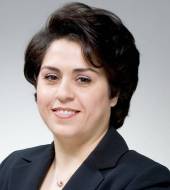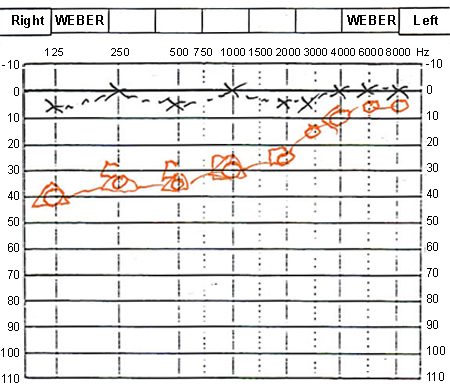Summary
Definition
ანამნეზი და გასინჯვა
ძირითადი დიაგნოსტიკური ფაქტორები
- vertigo
- hearing loss
- tinnitus
- aural fullness
- drop attacks
სხვა დიაგნოსტიკური ფაქტორები
- positive Romberg test
- Fukuda stepping test
- bilateral symptoms
- nystagmus
- tandem walk
რისკფაქტორები
- recent viral infection
- genetic predisposition
- autoimmune disease
- increasing age
დიაგნოსტიკური კვლევები
1-ად შესაკვეთი გამოკვლევები
- pure-tone air and bone conduction with masking
- speech audiometry
- tympanometry/immittance/stapedial reflex levels
- otoacoustic emissions (OAE)
გასათვალისწინებელი კვლევები
- electrocochleography
- electronystagmography
- rotary chair test
- vestibular-evoked myogenic potential (VEMP)
- MRI of internal auditory canals
- thyroid function tests
- Lyme disease and syphilis serology
- antinuclear antibody
- antineutrophil cytoplasmic antibody
- rheumatoid factor
ახალი ტესტები
- 3-dimensional MRI
მკურნალობის ალგორითმი
all patients
persistent hearing loss
failure of medical and intratympanic therapies; hearing adequate
failure of medical and intratympanic therapies; hearing severely impaired
კონტრიბუტორები
ავტორები
Soha N. Ghossaini, MD, FACS

Otology-Neurotology
Ear Nose and Throat Associates of New York
New York
NY
გაფრთხილება:
SNG declares that she has no competing interests.
მადლიერება
Dr Ghossaini would like to gratefully acknowledge the late Professor Maurice H. Miller, a previous contributor to this topic. MHM declared that he had no competing interests.
რეცენზენტები
Steven D. Rauch, MD
Associate Professor of Otology and Laryngology
Harvard Medical School
Boston
MA
გაფრთხილება:
SDR declares that he has no competing interests.
Christopher J. Linstrom, MD
Professor
Otolaryngology/Head and Neck Surgery
The New York Eye and Ear Infirmary
Surgeon Director
New York
NY
გაფრთხილება:
CJL declares that he has no competing interests.
Peter Rea, MA, BM BCh, FRCS(ORL-HNS)
Consultant ENT Surgeon
Leicester Royal Infirmary
Leicester
UK
გაფრთხილება:
PR declares that he has no competing interests.
Doris Eva Bamiou, MD, MSc, PhD
Clinical Senior Lecturer & Consultant in Audiovestibular Medicine
Ear Institute
University College London
London
UK
გაფრთხილება:
DEB declares that she has no competing interests.
რეცენზენტების განცხადებები
BMJ Best Practice-ის თემების განახლება სხვადასხვა პერიოდულობით ხდება მტკიცებულებებისა და რეკომენდაციების განვითარების შესაბამისად. ქვემოთ ჩამოთვლილმა რეცენზენტებმა თემის არსებობის მანძილზე კონტენტს ერთხელ მაინც გადახედეს.
გაფრთხილება
რეცენზენტების აფილიაციები და გაფრთხილებები მოცემულია გადახედვის მომენტისთვის.
წყაროები
ძირითადი სტატიები
Goebel JA. 2015 Equilibrium Committee amendment to the 1995 AAO-HNS guidelines for the definition of Ménière's disease. Otolaryngol Head Neck Surg. 2016 Mar;154(3):403-4. აბსტრაქტი
Basura GJ, Adams ME, Monfared A, et al. Clinical practice guideline: Ménière's disease. Otolaryngol Head Neck Surg. 2020 Apr;162(suppl 2):S1-55.სრული ტექსტი აბსტრაქტი
Lopez-Escamez JA, Carey J, Chung WH, et al; Classification Committee of the Barany Society; Japan Society for Equilibrium Research; European Academy of Otology and Neurotology (EAONO); Equilibrium Committee of the American Academy of Otolaryngology-Head and Neck Surgery (AAO-HNS); Korean Balance Society. Diagnostic criteria for Menière's disease. J Vestib Res. 2015;25(1):1-7.სრული ტექსტი აბსტრაქტი
American College of Radiology. ACR appropriateness criteria: hearing loss and/or vertigo. 2018 [internet publication].სრული ტექსტი
გამოყენებული სტატიები
ამ თემაში მოხსენიებული წყაროების სრული სია ხელმისაწვდომია მომხმარებლებისთვის, რომლებსაც აქვთ წვდომა BMJ Best Practice-ის ყველა ნაწილზე.

დიფერენციული დიაგნოზები
- Acoustic neuroma
- Vestibular migraine (also called migraine-associated dizziness and migraine-associated vertigo)
- Vestibular neuronitis
მეტი დიფერენციული დიაგნოზებიგაიდლაინები
- Clinical practice guideline: Ménière's disease
- Clinical practice guideline: sudden hearing loss (update)
მეტი გაიდლაინებიპაციენტის ბროშურები
Tinnitus
Meniere disease
მეტი პაციენტის ბროშურებიშედით სისტემაში ან გამოიწერეთ BMJ Best Practice
ამ მასალის გამოყენება ექვემდებარება ჩვენს განცხადებას